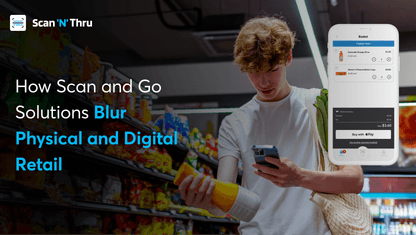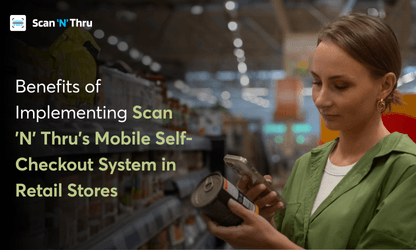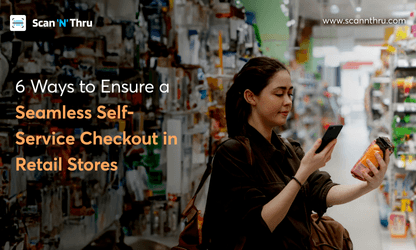Consumers have changed. Their shopping behavior and habits have changed. They expect speed, convenience, and autonomy.
The traditional in-store checkout processes, and even self-checkout lanes (in some cases), are ineffective in meeting these expectations.
Long lines, frustrated customers, and slow checkout processes aren’t just inconveniences. They’re profit killers. That’s also lost revenue, lost loyalty, and a tarnished brand reputation—all because of an outdated system.
Now the surprising thing is that many retailers like you know there are better and more efficient systems like mobile self-checkout. But due to many myths and misconceptions, they keep having second thoughts about implementing it in their stores.
So, in this blog, we’ll tackle the biggest myths surrounding mobile self-checkout. By debunking these misconceptions, we aim to equip retailers like you with the facts you need to make an informed decision—and take control of your checkout process before it costs you even more.
Let’s get into it.
Where do misconceptions about mobile checkout stem from?
Misunderstandings rarely come from bad intentions. They usually come from outdated experiences or secondhand stories. Let’s explore where these misconceptions often begin.
Legacy systems and outdated retail models
If your store still runs on a legacy POS system built a couple of decades ago, it’s easy to assume that newer technology is incompatible—or just not worth the hassle.
Many retailers compare mobile self-checkout technology to what worked in 2010, rather than considering what customers have gotten used to and expect in 2025.
No doubt, mobile self-checkout systems are still relatively new, but assuming that they are risky and complex is far from what’s true.
These systems are built to fit today’s consumer behavior and habits—seamless, digital-first, and mobile-friendly.
Misinformation or one-off negative experiences
Just like it usually happens with any technology, there were early mobile checkout implementations that didn’t go smoothly. Maybe you know that someone. But the thing is that your judgment shouldn’t be based on that sole experience.
One poor rollout shouldn’t define an entire technology.
Unfortunately, these rare negative experiences tend to get more attention than the success stories. A single glitchy app or confusing user interface from years ago can wrongly label mobile self-checkout as unreliable, even though the tech has evolved dramatically since.
That’s the thing about any technology—it keeps on getting better after its initial rollout, mostly based on real feedback.
Now, let’s take a closer look at the most common myths—and the facts that debunk them.
Myth 1: Mobile self-checkout is only for tech-savvy customers
It’s such a common concern for retailers that now it sounds cliche: “What if my older customers don’t want to use it?” Or “Won’t people prefer to stick with what they know?”
Older customers not being tech-savvy is a genuine concern, nevertheless. However, if these ‘older customers’ can use banking apps on their smartphones, FaceTime their loved ones, and know how to use Facebook, then surely mobile self-checkout will not be a big deal for them.
Perhaps you’re underestimating them.
The reality
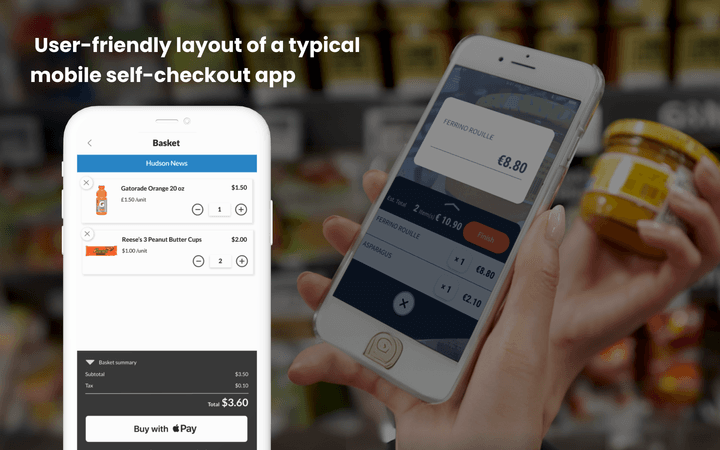
Today’s mobile self-checkout experiences are designed to be intuitive for everyone—not just digital natives.
Mobile self-checkout app’s interfaces mirror familiar smartphone interactions that most people already perform dozens of times daily.
With clear buttons, guided steps, and simple interfaces, they’re easy for all age groups to use.
Many shoppers already use their phones to compare prices or search reviews, so scanning products in-store and paying through an app will not bother them much.
Apart from that, retailers like you can encourage adoption through:
- On-floor staff guiding first-time users
- Signage that highlights benefits like “skip the line”
- Incentives like loyalty points for mobile checkouts
The result? More control for customers and smoother store traffic flow for you.
Myth 2: It’s expensive and difficult to implement
This one stops a lot of retailers before they even begin. The fear of ripping out existing infrastructure or spending months integrating systems is real, but outdated.
The reality
Modern mobile self-checkout platforms are built to integrate seamlessly with your existing POS and inventory systems. Many are cloud-based, which means there’s no hardware to install and updates happen automatically.
Even better—while there is an upfront investment, retailers often recoup the costs quickly through:
- Reduced cashier staffing needs
- Increased basket sizes
- Faster checkout throughput
It’s not just a cost; it’s an efficiency multiplier. And the real cost question isn't implementation—it's the opportunity cost of customers who abandon purchases due to long lines.
Myth 3: Mobile self-checkout replaces human interaction entirely
Some retailers fear that by adopting mobile checkout, they’ll lose the personal touch that sets them apart.
What they don’t realize is that their store cashiers are too busy scanning items to have meaningful customer interactions.
But removing the traditional checkout counter doesn’t mean removing your team.
The reality
Mobile self-checkout doesn’t replace human interaction—it enhances it.
Instead of standing behind a register, your team can now:
- Greet customers and answer questions
- Help shoppers use the app if needed
- Focus on restocking or merchandising
Think about it: wouldn’t you rather have associates helping shoppers find products, restocking shelves, or resolving issues instead of standing behind a counter all day?
Freeing up your team allows them to create deeper connections with customers—and that’s where loyalty is built.
Myth 4: Mobile self-checkout only works for large retailers
Big brands might’ve been the first to test it out, but mobile checkout isn’t just for giants anymore.
The reality
Solutions like Scan ‘N’ Thru are built to be scalable. Whether you’re running a single-location boutique, a grocery chain, or a specialty store, mobile self-checkout technology fits.
In fact, smaller retailers may benefit even more because of:
- Reduced operating costs
- Improved staff productivity
- A modern, tech-forward shopping experience that builds loyalty
The scalability advantage extends to store size as well. Mobile-based self-checkout solutions eliminate the spatial constraints of fixed checkout lanes. This can be incredibly valuable for small retail stores where every square foot must generate revenue.
Myth 5: Mobile self-checkout removes upselling and impulse purchases
Some worry that removing the face-to-face checkout interaction also removes last-minute add-ons or product suggestions.
The reality
AI-driven recommendations during checkout can actually increase basket sizes.
Mobile-based self-checkout opens up new ways to upsell:
- AI-driven product recommendations based on cart behavior
- Real-time promotions pushed through the app
- Custom bundles or add-ons can be shown before payment

While physical checkout lanes limit merchandising to whatever fits on nearby shelves, mobile interfaces can dynamically suggest relevant products based on what's in your customer's basket, past purchases, and real-time inventory.
It’s like turning your checkout process into a personalized marketing tool.
Myth 6: Customers will miss the traditional checkout experience
There’s a belief that shoppers enjoy chatting with cashiers or waiting in line as part of the shopping ritual. But in reality, most customers are just trying to get in, get what they need, and move on.
The truth is that nobody likes waiting in queues. A 2023 study from Waitwhile found that 82% of shoppers avoid going to businesses just because of a visible waiting line, or they think they will have to wait in line to finish their shopping.
The reality
Customers don’t miss long lines or slow service—they miss control. Mobile self-checkout gives them exactly that.
With mobile checkout, they:
- Skip the line entirely
- Scan products and shop at their own pace
- Avoid unnecessary interactions when in a rush
You don’t have to worry about your customers missing the traditional checkout methods. Most of them actually love and prefer self-checkout.
In a 2023 article, Grocery Drive reported the findings from VideoMining’s study, revealing that self-checkout usage saw 53% growth in five years.
The same report also revealed that by the end of 2022, self-checkout made up nearly half (48%) of all checkout registers. This shows just how quickly shoppers are getting used to— and even preferring— these systems.
And if they need assistance? Staff are still available—just more focused on meaningful help rather than transactional tasks.
Customer-centric benefits of mobile self-checkout
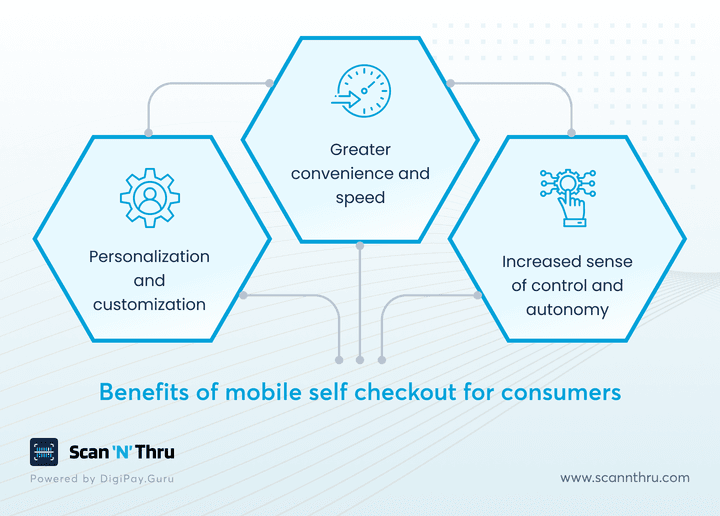
Now that we’ve busted the myths, let’s zoom in on the benefits. So what does all this mean for your customers? Let’s break it down.
Personalization and customization
Mobile self-checkout systems like Scan ‘N’ Thru can integrate with your loyalty programs and customer profiles. That means you can provide:
- Personalized discounts
- Purchase-based rewards
- Tailored suggestions
These digital moments build customer profiles that power increasingly personalized shopping experiences.
When customers feel seen and valued, they come back.
Greater convenience and speed
Forget the line. Shoppers scan as they go and pay when ready—all from their smartphones.
Beyond time savings, mobile self-checkout technology also removes psychological friction points—the visible line, the uncertainty about wait times, and the pressure to unload and reload items quickly.
Add in mobile wallets, loyalty points, and fast contactless payments, and you’ve got the quickest checkout experience in retail.
Increased sense of control and autonomy
People love feeling in control, and mobile self-checkout apps give them exactly that. No waiting, no awkward bagging moments, no pressure. Just freedom.
This control and autonomy extend beyond just scanning products on their own. Features like digital receipts, real-time loyalty point tracking, and saved shopping lists create an ecosystem of convenience that builds lasting engagement with your brand.
Final thoughts
Every myth we’ve debunked today points to one undeniable truth: this technology isn’t just about keeping up—it’s about staying ahead.
If you’re still hesitating, ask yourself this: do you want to be the retailer that clings to outdated systems while your competitors thrive? Or do you want to be the one who delivers speed, convenience, and innovation to your customers?
Believing in outdated myths only delays progress—and gives your competitors a head start. Whether you’re running a small neighborhood shop or managing multiple stores, Scan ‘N’ Thru helps you keep up with how customers want to shop.
Still unsure? Don’t go it alone. Our team is here to help you understand what’s possible, how to implement it, and what kind of results to expect.



